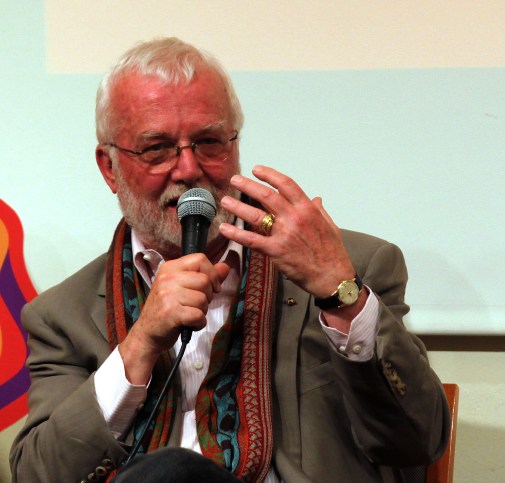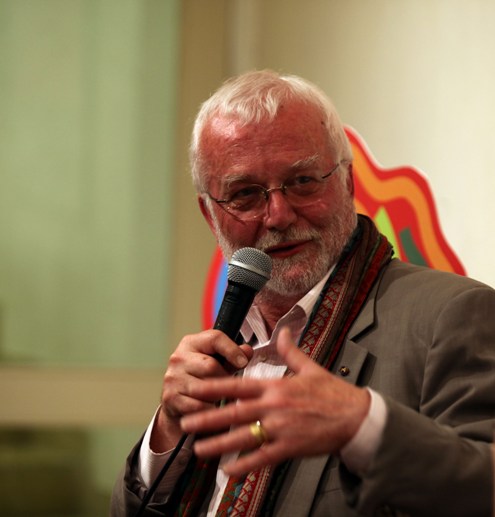On Monday night, as part of the 2nd International Writers Festival 2010, Russell Banks introduced the film ‘The Sweet Hereafter’, which is based on his 1991 novel. At the sold out screening at the Jerusalem Cinematheque, Banks discussed the film, the novel, and adaptation in general.
Earlier in the day, Banks was presented the newly released Hebrew translation to his novel. “It’s a lovely moment for me”. He finds it “a little frightening but also at the same time a little awe-inspiring” that something one writes in his own vernacular language about some personally significant mystery is shared not only by people with a shared cultural background, but later appears “in another language for another audience thousands of miles away with another cultural frame of reference another historical frame of reference which will nonetheless be able to read the novel and somehow take it personally”.
Referring then to the film, Banks said “Sometimes I’ve heard people describe adaptation as a translation and I quickly try to correct that”. After working on this film, as well as having his novel ‘Affliction’ adapted for the screen, Banks realized that “really, it’s not at all translation, and shouldn’t be understood as such. In fact ‘adaptation’ is an inadequate word to describe the process of transferring a novel into film.”
To explain his ideas about adaptation, he’s even come up with a metaphor for the process.
“If you think of the novelist as a potter- a man or a woman working alone with a lump of clay and shaping a three dimensional object with no other person involved in the process and no other material except that shapeless lump of clay. And creating out of that a grand jar, let’s say.” The Jar has “a flat base, round sides, in three dimensions. That’s the novel, and that’s how the novelist works.
“Along comes the director, or screenwriter or producer and they say they want to make a film from it. At that point, it’s as if you took the jar and smashed it on the floor, broke it into a thousand pieces, most of which are curved, but the bottom is flat. And what they want to make of it, let’s say, is a two dimensional object, think of stained-glass window. If you know anything about stain-glass windows, you know that they’re not just two dimensional, they’re usually made by a guild- there’s the person who designs it, the person who builds the frame for it, the person who does the leading and the cutting of pieces to fit in and so forth. And they go through the pile of shards that lie on the floor and they only pick out of that the pieces that will allow them to make that two dimensional object.
“So you’ve gone from a three dimensional object to a two dimensional object, and you’ve only taken some of the pieces out of that pile, and you’ve done it collaboratively- you’ve done it with many people, a guild of craftsman. That’s the kind of transference that occurs when a novel is adapted into film. And it’s so radically different, going from one medium into the other that I’m reluctant to use the word’ adaptation’ and I refuse to use the word ‘translation’ when talking about that process.”
* * * * * * * * * *

When writing the ‘The Sweet Hereafter’, it never occurred to Banks that it might be adapted to film. “It’s a grim story, I must say. It begins with a school-bus accident in a small town in upstate New York in the winter, and then follows the aftermath of that accident in the town, where a number of children of the community are killed.”
It presents a mosaic of this community, and shows the families and neighbors attempting to cope with the unimaginable tragedy. After the accident, a horde of lawyers descend on the town in the interest of representing the families in a class-action suit. One of them, Mitchell Stephens, manages to convince a number of the families to hire him, and he sets about interviewing everyone involved. Two of the key people in the suit are Dolores, the bus-driver, as well as 14 year old Nicole Burnell, who was crippled by the accident.
“I wrote it without a central protagonist because I wanted the community itself to be the protagonist” Banks explained “I wanted to explore certain ideas, puzzles, questions and mysteries that preoccupied me at the time- about community, about children, about the litigious nature of American society, and about cause with regard to the inexplicable kind of event that a school bus accident might propose to a community.”
In addition to the grimness of the story, the novel is presented from the points of view of four different narrators, which reinforced Banks’ opinion that it would be very difficult to adapt it to film.
Enter Canadian filmmaker Atom Egoyan, who had gotten some attention for his 1994 film ‘Exotica’. Egoyan was convinced that there was a film to be made of the material, and was intent on working with Banks every step of the way to keep the spirit of the novel intact. “He was an extremely generous man, who brought me in to the process right from the start. We worked on the script back and forth- he sent me every draft, I critiqued his version, and he would critique my critique”.
Changes were made, both big and small, to the plot and the characters. The setting moved from Upstate New York to British Columbia, the horde of lawyers were condensed to just Mitchell Stephen, who is played by British actor Ian Holm. Gone is the element of American litigious tendencies. Also gone is the original finale of the book, which brought all the characters together as they attend a Demolition derby.
In the film, the story is presented in a non-linear fashion- different timelines and characters weave in and out of one another. As a unifying element, Egoyan introduced the framing device of Robert Browning’s poem ‘The Pied Piper of Hamelin’.
There are several versions of the story, but as the poem goes, the Piper arrived in a small town one day, and offered to rid the town of its rats, in exchange for payment. Once he drowns all the rats, however, the town refused to pay him. His revenge comes when one day, while the parents are in church, he plays his pipe and lures the children of the town through music to follow him to a nearby cave, from which they never returned. The only child that is spared is a lame boy, who, due to his crutches, is unable to keep up.
When Egoyan first raised the notion of extensively referencing the tale, Banks “felt terrible about it. There’s nothing like that in the novel- a couple of allusions, but they’re very obscure, you’d have to hunt to find them. When Atom first presented the idea I said ‘No, no, no. You can’t use that, it’s too literary, it’s too obvious. I could never get away with that in the novel- it’s simply too literary’. He said ‘Yeah, but it won’t work that way in the movie’.”
Eventually Banks became convinced that it would work, partly after the realization that the original ending wouldn’t be appropriate for the film. “He (Egoyan) reminded me that the most cinematic aspect of the novel was the Demolition Derby at the end”. That scene was the thing that most attracted him to adapting that novel in the first place, as it seemed to be extremely cinematic. When he got down to it, however, “he realized there was no way he could use it in the film. It was too big and too violent for the tone of the film. With a novel, you can cool down something as violent and noisy as that. You can put a scrim, a prose scrim between the reader and the event you describe, and it can almost go by in silence. In a movie, you can’t do that. So he threw out the most cinematic piece of the novel, and he inserted the Pied Piper, who was too literary for me to use in the novel. I thought it worked well, because as you watch it, you don’t know who the Pied Piper is. Is it the lawyer? Is it Nicole Burnall- the girl? Is it the father of the children who are lost? Is it the bus-driver? Who is the Pied Piper here? And it moves- it’s a way of uniting and bringing together the various characters, and keeping any one of them from taking it over. He used it, I thought, very intelligently.”
Despite the changes to the specifics of the story, Banks says he is in “that unusual position for a novelist- happy with the film adaptation of my novel”, which he went on to explain- “A faithful adaptation, to my mind, is not one that captures the plot, and perhaps not one that really captures the character. There are characters in the novel that are left out of the film, and certainly the plot has been shifted around some. The thing that has remained however, from beginning to end, is the tone and the atmosphere of the novel. It’s an elegiac novel. It’s a melancholy novel. It’s a serious novel. And the film is elegiac and melancholy and ultimately very serious. The tone of it, the look of it, the details in it all correspond to that tone and atmosphere and details of the novel. They’re not the same details, but they have the same feeling. And that’s what mattered most to me- the plot didn’t really matter, all the characters didn’t matter. The feeling mattered, and I think he captured that.”
* * * * * * * * * *
After the introduction, Banks took a number of questions from audience members on matters literary, cinematic, and the space between them. In reference to the introduction, he was asked about whether he believes that film is an art-form with fewer dimensions than literature:
“They’re incomparable, in the same way that a stained-glass window can’t be compared to a jar, I think. It’s either a work of art which raises important and personally meaningful questions for the viewer, or it’s not. And the same thing can be said of a novel. And in this case, I don’t think it’s a diminishment. We have different application of film in our lives than we do for a novel. We listen to a novel differently, experience it differently. I tip-toe around any comparisons, as you can tell.
“When you’re a reader, you help in the creative process. You’re an active participant in the creative act when you read a book. You bring to it your memories and your fantasies and your dreams and the accidents of the day and you fill it out. You internalize it, whereas you’re a much more passive participant as an audience when you’re experiencing a film. It imposes itself on you.
“It’s the difference between push and pull- a book pulls you, whereas a film pushed you, and that is such a radically different relationship to the work of art. I don’t want to make a hierarchy, though.”
When asked about the short story form, as opposed to the novel form:
“I feel like it’s a very different medium- it’s as different from the novel as a lyric poem is, and in many of the same ways. Edgar Allen Poe described a short story as a story that could be read in one sitting. I think what he was really describing is that a short story only makes sense if, when you get to the end, you can remember the beginning. Otherwise, the ending doesn’t make sense. You have to hold the beginning in your head. Just as in a lyric poem, when you get to the last couplet in lyric poem, it only makes sense if you can hear the echo of the first couplet. The short story is much closer to poetry than to the novel. Every single word counts in a short story.
“For a novel, it’s the opposite. With a novel, the idea is to forget the beginning. When you read a novel, 50-75 pages in, you no longer remember the beginning. If it’s a good novel, it’s imitating the flow of time in a way that the short story doesn’t. The short story is outside of time, much more formally constructed. I think that’s the essential difference. I think it’s very difficult to adapt short stories to film, because to do that, you’ve got to add on and add on. They make good shorts, but they rarely make a good full-length feature. Because you need to add too much, and in any good film, 30 minutes in, you’ve forgotten the beginning. It’s the flow of time- you can’t remember your birth. There’s a very different relationship to time and the way one experiences time”
Banks was also asked about whether the existence of the film changes his perception of the novel:
“I wrote an essay about the process once- it was called ‘No, but I saw the movie’. And it was about people who at book signings say just that. And I know they’re never gonna read the book.
I don’t think it’s effected my perception of the novel. I think that I feel intimately connected to the text. I also feel very connected to the film -or else I wouldn’t be here this evening- but it’s a very different connection. And the connection I have today with that novel is very similar to the connection I have with books that go back as far or further that were never adapted. I don’t think it was affected by that. However, there was a film adaptation of a novel mine called ‘Affliction’, and that’s a kind of a star vehicle in the sense that Nick Nolte played the lead in that and James Coburn played the second lead and Willem Defoe played the third lead in it, and these faces have transposed themselves onto my remembered faces of the character in the novel, just as they’ve super-imposed themselves onto the cover of the movie tie-in edition. So I no longer can think of those characters without seeing Nick Nolte’s face and Willem Defoe and James Coburn. Maybe it’s because they have such powerful faces, but it’s also because of all the publicity material, and the posters and the covers (laughs). It’s just erased what I once had in my head.”
Finally, he was asked whether he had a favorite character in ‘The Sweet Hereafter’:
“Yes. I confess, I did. I usually feel a very powerful affection for all my character, regardless of whether they’re nice people. I don’t think a character can mean much to you unless you have that affectionate connection. They’re your family, in a sense. But in this case, there’s an adolescent girl that’s central to the story, Nicole Burnall, and she’s the character I think I ended up caring about the most. The way I can measure this is that after the book was finished -even now, many years later- I still wonder what kind of adult she turned out to be. There are two characters I feel about like that- the other one is in ‘Rule of the Bone’. That too is an adolescent character, a boy, and he too I feel the same special affection for. I think that’s because I leave them, at the end of the novel, as adolescents, and they’re still alive –which is always good- and they have a future. And I wonder what happened to them, years later.”
* * * * * * * * * *
Banks closed his introduction with a bit of Hemingway:
“Ernest Hemingway advised novelists- When Hollywood wants to make a movie out of your novel, the way you handle it is you get in your car and you drive west -he assumed all novelists lived in the east- to the Nevada/California border, and you throw your novel over the line, and they throw the money back, and you get in your car and you go home.
“Up to that point, that’s pretty much how I had operated in regards to any film interest in my books. But this time I had gotten involved in the process myself to an enormous degree, and that’s because, in the end, I believed that it was a work of art.”
SHLOMO PORATH








